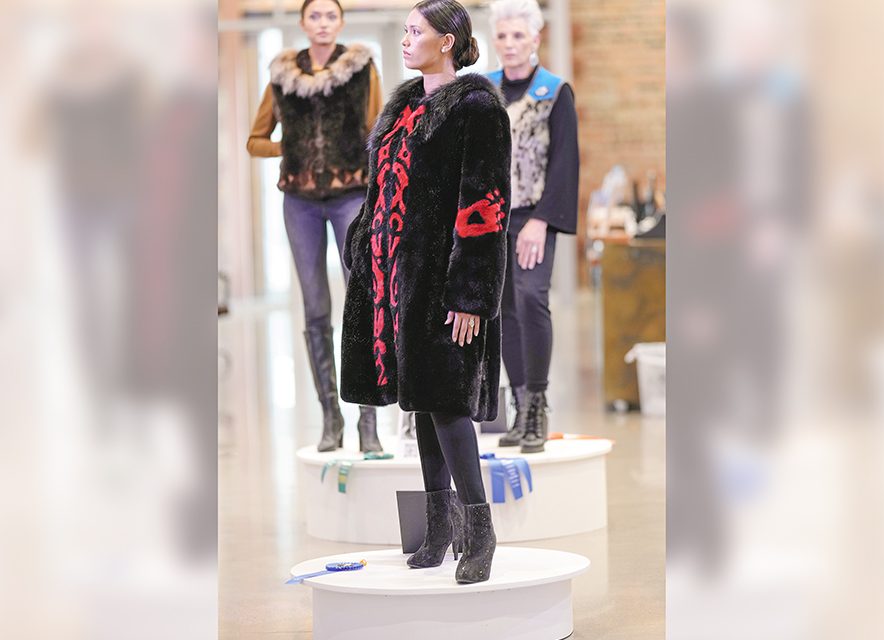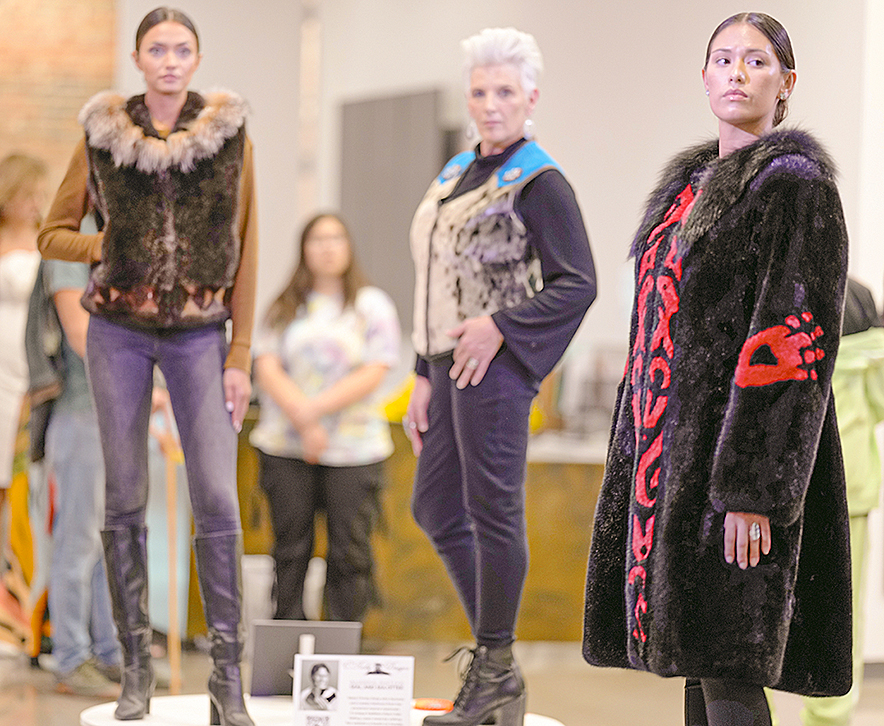
The art of tradition: Christy Ruby, Tlingit artist and hunter

Special to the Times | Donovan Quintero
Model Jula Harjo showcases a sea otter fur coat, “Black Blood,” which received the 2024 Innovation Award during the annual SWAIA – Santa Fe Indian Market Aug. 17. Black Blood was designed by Christy Ruby of the Tlingit Tribe.
By Donovan Quintero
Special to the Times
SANTA FE — In the coastal town of Ketchikan, Alaska, where the mist rolls off the water and the mountains rise like sentinels, Christy Ruby stands out not just for her Tlingit heritage but for her unique blend of artistry and traditional hunting.
Unlike many clothing designers who may begin their process at a drawing table, Ruby’s journey starts with a 22-250 Remington rifle.
“First, it takes a person to go on a boat at twenty degrees with a nice rifle, and go hunt the animals, which is what I do,” Ruby explains. “Don’t let the dress fool you.”
Clad in traditional Tlingit attire, and nearly 2,200 miles away from her homeland, Ruby stood by and watched admirers eye her designs on the evening of Aug. 17, at the 2024 Santa Fe Indian Market Gala & Live Auction, held at the New Mexico Museum of Art’s Vladem Contemporary.
Harvesting traditional animals
Ruby’s artistry revolves around harvesting traditional animals like seals and sea otters, not only for their meat but also for their fur, which she transforms into wearable art. This dual-purpose approach—sustaining her community and reviving a fading tradition—has become her life’s work.

Special to the Times | Donovan Quintero
Model Jula Harjo showcases “Black Blood” during a fashion show at the SWAIA – Santa Fe Indian Market Aug. 17. Harjo is the first person to model the sea otter fur coat.
“It hasn’t been easy,” she admits, reflecting on a challenging career. “It is filled with a lot of setbacks, hurdles, and controversy. But I’m not a quitter.”
Ruby says she was born and raised in a hunting family. She explained in a straightforward, innate Tlingit toughness that to survive in Alaska, one must hunt.
“You have to live off the land up there because food’s too expensive. It’s hard to get good food, and it’s not healthy what they’re serving now, it’s not healthy, the food, the chemicals in the food we eat,” she said. “I’d much rather have deer steak than a beef steak any day because I know where the deer was eating and where he was living.”
Her resilience shines through as she recounts how she began hunting seals, providing food and tanned skins for the elders in her community. Over time, she connected with mentors who taught her the intricate art of harvesting sea otters.
Despite their adorable appearance, Ruby notes that sea otters have become a concern due to their overpopulation in southeast Alaska.
“I know they are super cute, but they are overpopulating southeast Alaska. The traditional foods we rely on are in jeopardy due to their insatiable appetites,” she explains, highlighting a critical ecological balance that is under threat.
Devastating the clam population
The harvesting of seals and sea otters is strictly regulated by the federal government, with only Alaskan Natives permitted to hunt these animals.
She explained sea otters, when left unchecked, can devastate the clam population, which in turn can cause a clam shortage for the Tlingit people who’ve relied on clams as part of the traditional staple diet for eons.
“It’s a native food for us, and so we rely on those foods to feed our families,” said Ruby, adding that sea otters can destroy whole clam populations within a month. “There’d be nothing left.”
She does acknowledge that sea otters also help keep the clam population healthy.
“They till the ground — what was hard, compact soils and dead clams over years and years and years of not having any sea otters — it gets fluffed up and reseeded from other clams,” she explained, “and you’ll find thousands of clams in about five years.”
However, the path for artists like Ruby is becoming increasingly difficult. Tanneries in the region are closing, a consequence of soaring inflation, dwindling expertise, and shifting public sentiment toward fur.
“This is breaking my heart and those of other Alaskan Natives who depend on apparel sales to compensate for the high costs of living in remote areas,” Ruby laments.
Keeping traditions alive, rifle in hand
Her work involves navigating the complexities of various textures, lengths, and colors of fur. Each piece tells a story, drawing from her heritage while combating the forces that threaten its survival. Ruby believes that art is not merely a hobby; it’s a way to keep traditions alive and relevant.
“I hunt deer for meat for our family. I hunt seal for meat for our family. I hunt sea otters to help control the crab population and help boost the clams because they’re getting overactive and evasive right now and eating all our seafood,” said Ruby. “And I also hunt moose and other animals for food.”
Her clothing is mostly made up of seal and sea otter and does incorporate various furs — beaver, lynx, and fox — she gets from native trappers from places up in western Alaska like Kotzebue and Nome.
In southeastern Alaska, where the summer, water temperatures generally stay below 60 degrees, it is the extreme tidal currents, where they can fluctuate over 20 feet, Ruby prepares for the dangers these major hazards she’ll no doubt encounter.
“You’ll need a boat that can handle six to seven-foot waves. And I never, ever, ever, ever leave the dock without knowing that my kicker will be working,” Ruby emphatically emphasized as she explained what a kicker is, which she said is a spare boat motor. “So, you’re not stranded out seven or eight miles in the middle of nowhere where there is nobody. I don’t usually go on a boat that doesn’t isn’t seaworthy.”
After she’s prepared her boat, she then focuses on ensuring she’s packed her emergency kits, three days of food, three days of warmth and blankets, and separate warm clothes.
“It’s pretty isolated where I hunt,” she said.
Her meticulousness to detail she puts into what she’ll embody in her works of art paid off this year when she was awarded the Bernard Ewell Innovation Award, for her sea otter fur coat she calls “Black Blood.” Ruby wrote about life’s joys and anguish, which she wrote in her traditional Tlingit language on the inside of the coat.
The coat was modeled for the first time during the live auction and was received with admiration and appreciation. Ruby was also honored with the Best of Division award during the Indian market festive weekend.
In addition to her artistry, Ruby is committed to educating others about the importance of sustainable hunting and the cultural significance of her work. She often hosts workshops and community events, sharing her knowledge of traditional methods and the ethics behind them. “It’s about preservation, not just for us but for future generations,” she states with conviction.
For Ruby, the intersection of artistry and tradition is not only a means of self-expression but a vital link to her ancestors and her community. In a world that often overlooks the richness of Indigenous cultures, the award-winning Tlingit clothing designer stands resiliently — with her rifle in hand.
Through her art and her hunting, she said she is not just preserving a way of life; she is redefining it for the modern age.
Ruby said she is already preparing for her next expedition into the wilderness. She plans to hunt for meat for her family and the elders. Perhaps, her next design will be determined by what her adventure reveals to her during her hunting endeavors.








 Highway 264,
Highway 264, I-40, WB @ Winslow
I-40, WB @ Winslow